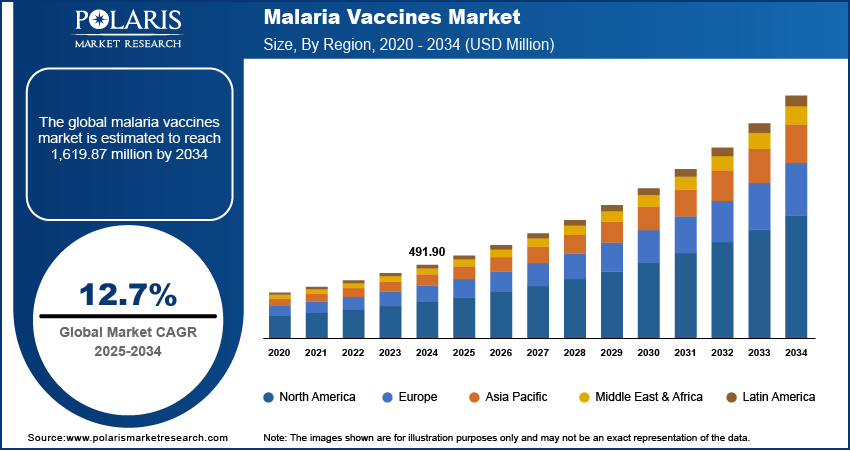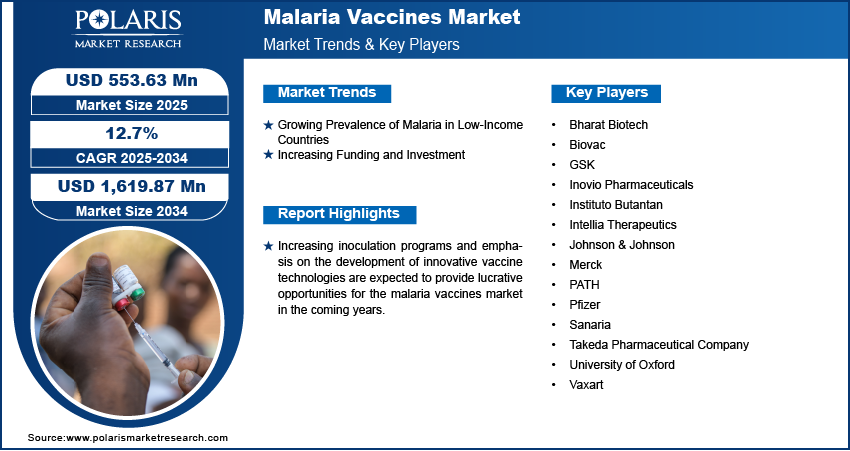
Malaria Vaccines Market Size, Share, Trends, Industry Analysis Report: By Vaccine Type, Administration Route (Subcutaneous and Intramuscular), Target Population, Immunization Schedule, Development Stage, and Region (North America, Europe, Asia Pacific, Latin America, and Middle East & Africa) – Market Forecast, 2025–2034
- Published Date:Feb-2025
- Pages: 114
- Format: PDF
- Report ID: PM1525
- Base Year: 2024
- Historical Data: 2020-2023
Malaria Vaccines Market Overview
The global malaria vaccines market size was valued at USD 491.90 million in 2024. The market is projected to grow from USD 553.63 million in 2025 to USD 1,619.87 million by 2034. It is projected to exhibit a CAGR of 12.7% from 2025 to 2034.
Malaria is a widespread disease caused by a parasitic infection from the protozoan Plasmodium, which is usually transmitted through the bite of different species of Anopheles mosquitoes. Among the various Plasmodium species, four commonly infect humans as their primary host. These species are P. ovale, P. vivax, P. falciparum, and P. malariae. Malaria vaccines are immunizations designed to combat the Plasmodium parasite that infects humans. RTS,S/AS01, R21/Matrix-M, and PfSPZ are the main types of malaria vaccines.
The rising global incidence of malaria, especially in sub-Saharan Africa and other endemic regions, is driving the malaria vaccines market demand. In addition, the introduction of low-cost vaccines by pharmaceutical companies to make them more accessible in developing nations is supporting the development of the market. Further, growing awareness about the aftereffects of malaria is boosting the adoption of malaria vaccines.
The growing consumer demand for preventive healthcare is one of the major emerging malaria vaccines market trends. Increasing inoculation programs and emphasis on the development of innovative vaccine technologies are projected to provide several malaria vaccines market opportunities during the forecast period.

To Understand More About this Research: Request a Free Sample Report
Malaria Vaccines Market Dynamics
Growing Prevalence of Malaria in Low-Income Countries
The malaria epidemic is spreading, and climate change is creating more favorable conditions for mosquito vectors to thrive. According to the World Health Organization (WHO), there were 263 million cases of malaria worldwide in 2023, up from 252 million cases in 2022. The estimated number of deaths from malaria stood at 597,000 in 2023. Malaria has primarily affected tropical regions such as South America, Central America, Asia, and Africa. In addition, it is most common in the Western Pacific, the Eastern Mediterranean, and Southeast Asia. Thus, the rising prevalence of malaria in low-income nations is driving the malaria vaccines market development.
Increasing Funding and Investment
The combined efforts from governments, private investors, and international organizations play a crucial role in driving vaccine development. With the rising global demand for malaria vaccines, increased investment fuels innovation in vaccine research and encourages competition within the pharmaceutical industry. Investments and funding also ensure that vaccines are produced at scale and can be delivered effectively to high-risk populations. Thus, the increased funding and investment from both private and public sectors are propelling the malaria vaccines market growth.

Malaria Vaccines Market Segment Insights
Malaria Vaccines Market Outlook Based on Vaccine Type
The malaria vaccines market, based on vaccine type, is segmented into PfSPZ; RTS,S/AS01; and R21/Matrix-M. The RTS,S/AS01 segment held the largest share of the market in 2024, owing to the extensive clinical research and trials demonstrating its efficacy. The RTS,S/AS01 vaccine targets the P. falciparum species, which is responsible for causing the most severe malaria cases, especially in children. Further, the rollout of RTS, S/AS01 in various African countries drives the robust growth of the segment.
Malaria Vaccines Market Evaluation Based on Administration Route
The malaria vaccines market, based on administration route, is bifurcated into subcutaneous and intramuscular. The intramuscular segment led the market in 2024, as it is the most widely used route for malaria vaccines, including R21/Matrix-M and RTS,S/AS01. The intramuscular route introduces the vaccine deep into muscle tissue, where it is slowly absorbed into the bloodstream. The slow delivery ensures consistent dosage and immunological response. Also, malaria vaccines delivered through the intramuscular route have shown a superior ability to induce the production of neutralizing antibodies compared to other routes.

Malaria Vaccines Market Regional Analysis
By region, the market report offers malaria vaccines market insights into North America, Europe, Asia Pacific, Latin America, and the Middle East & Africa. North America led the global malaria vaccines market share in 2024, owing to the strong presence of major pharmaceutical companies with significant investments in malaria vaccine development programs. Further, the introduction of favorable government regulations supporting malaria vaccine R&D initiatives drives the regional market demand.
The Middle East & Africa malaria vaccines market is projected to witness a significant CAGR from 2025 to 2034. With its considerable malaria burden, the region is likely to witness enhanced collaborations between government and private organizations to develop cost-effective malaria vaccines. The rising focus on improving healthcare infrastructure is also likely to present lucrative opportunities for vaccine adoption in the region during the forecast period.

Malaria Vaccines Market – Key Players and Competitive Insights
Leading market players are investing heavily in research and development to expand their offerings, which will help the malaria vaccines market grow even more. Market participants are also undertaking a variety of strategic activities to expand their global footprint, with important market developments such as innovative vaccine launches, international collaborations, higher investments, and mergers and acquisitions between organizations. To expand and survive in a more competitive and rising market environment, market participants must offer cost-effective vaccines.
The malaria vaccines market faces competition from major global players, fueled by rising demand for vaccines from low-income countries. The major players dominate the market with their extensive production capacities and advanced technologies. Competition is further heightened by stringent environmental regulations and the necessity for technological advancements to improve the efficacy of vaccines. A few of the leading market players are Instituto Butantan, Merck, PATH, GSK, Vaxart, Biovac, Pfizer, Inovio Pharmaceuticals, Bharat Biotech, University of Oxford, Intellia Therapeutics, Johnson & Johnson, Sanaria, and Takeda Pharmaceutical Company.
List of Key Players in Malaria Vaccines Market
- Bharat Biotech
- Biovac
- GSK
- Inovio Pharmaceuticals
- Instituto Butantan
- Intellia Therapeutics
- Johnson & Johnson
- Merck
- PATH
- Pfizer
- Sanaria
- Takeda Pharmaceutical Company
- University of Oxford
- Vaxart
Malaria Vaccines Industry Developments
May 2024: UNICEF announced the delivery of 43,000 doses of the R21/Matrix-M malaria vaccine to the Central African Republic. The agency stated that the development marks the first use of the R21 vaccine in routine childhood immunization.
September 2022: GSK plc announced that it received the World Health Organization (WHO) prequalification for its malaria vaccine, Mosquirix (RTS,S/AS01). According to GSK, the development marks an important step in rolling out the vaccine in regions with moderate to high malaria transmission.
Malaria Vaccines Market Segmentation
By Vaccine Type Outlook
- PfSPZ
- RTS,S/AS01
- R21/Matrix-M
By Administration Route Outlook
- Subcutaneous
- Intramuscular
By Target Population Outlook
- Travelers to Endemic Areas
- Pregnant Women
- Children Under 5 Years
By Immunization Schedule Outlook
- Single Dose
- Multi-Dose
- Booster Doses
By Development Stage Outlook
- Preclinical
- Clinical Trials
By Regional Outlook
- North America
- US
- Canada
- Europe
- Germany
- France
- UK
- Italy
- Spain
- Netherlands
- Russia
- Rest of Europe
- Asia Pacific
- China
- Japan
- India
- Malaysia
- South Korea
- Indonesia
- Australia
- Rest of Asia Pacific
- Middle East & Africa
- Saudi Arabia
- UAE
- Israel
- South Africa
- Rest of Middle East & Africa
- Latin America
- Mexico
- Brazil
- Argentina
- Rest of Latin America
Malaria Vaccines Market Report Scope
|
Report Attributes |
Details |
|
Market Size Value in 2024 |
USD 491.90 million |
|
Market Size Value in 2025 |
USD 553.63 million |
|
Revenue Forecast by 2034 |
USD 1,619.87 million |
|
CAGR |
12.7% from 2025 to 2034 |
|
Base Year |
2024 |
|
Historical Data |
2020–2023 |
|
Forecast Period |
2025–2034 |
|
Quantitative Units |
Revenue in USD million and CAGR from 2025 to 2034 |
|
Report Coverage |
Revenue Forecast, Market Competitive Landscape, Growth Factors, and Trends |
|
Segments Covered |
|
|
Regional Scope |
|
|
Competitive Landscape |
|
|
Report Format |
|
|
Customization |
Report customization as per your requirements with respect to countries, regions, and segmentation. |
FAQ's
• The malaria vaccines market size was valued at USD 491.90 million in 2024 and is projected to grow to USD 1,619.87 million by 2034
• The market is projected to register a CAGR of 12.7% from 2025 to 2034.
• North America accounted for the largest region-wise market size in 2024
• A few of the key players in the market are Instituto Butantan, Merck, PATH, GSK, Vaxart, Biovac, Pfizer, Inovio Pharmaceuticals, Bharat Biotech, University of Oxford, Intellia Therapeutics, Johnson & Johnson, Sanaria, and Takeda Pharmaceutical Company.
• The RTS,S/AS01 segment accounted for the largest market share in 2024.
• The intramuscular segment dominated the market in 2024.
